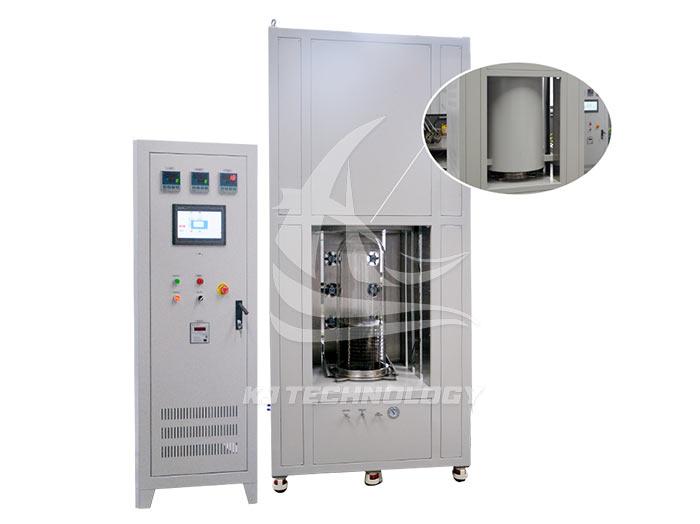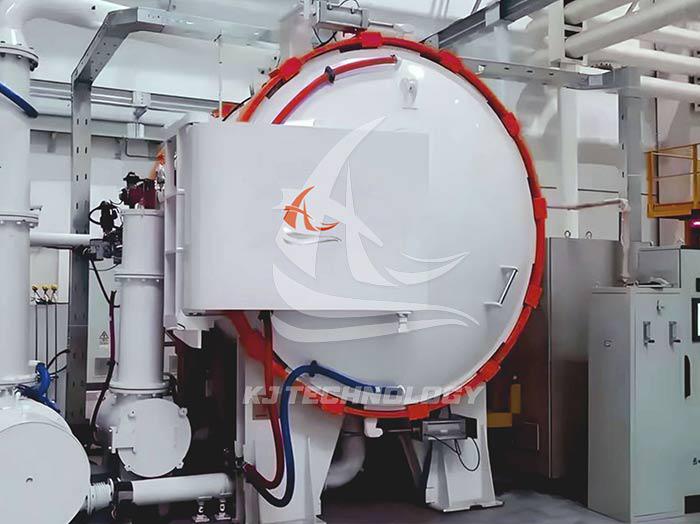Application of Vertical Graphite Vacuum Furnace in the New Materials Industry
 09-03-2025 Author: KJ technology
09-03-2025 Author: KJ technology
The vertical graphite vacuum furnace is widely and crucially used in the new materials industry. Through its high-temperature vacuum environment and unique properties of graphite materials, it significantly promotes the research and industrialization process of new materials. The specific application scenarios and analysis are as follows:
1. Core application scenarios
Preparation of graphite composite materials
The vertical graphite vacuum furnace promotes the composite of graphite with metals, ceramics, and other materials through a high-temperature vacuum environment, producing composite materials with conductivity, corrosion resistance, and high strength. For example, in the aerospace field, graphite metal composite materials are used to manufacture engine blades and thermal protection systems, and their high temperature resistance (up to 3000 ℃) and lightweight characteristics (density reduction of 40%) significantly improve aircraft performance.
Production of graphite foam material
Using the high-temperature foaming process in vacuum environment, the vertical graphite vacuum furnace can prepare lightweight and high-strength graphite foam materials. This material has excellent thermal insulation performance (thermal conductivity<0.1 W/m · K), sound absorption performance (noise reduction up to 30dB), and seismic performance, and is widely used in building insulation, aerospace insulation layers, and acoustic materials.
Purification of high-purity graphite
Through high-temperature vacuum environment (2800-3000 ℃) and long-term graphitization treatment, the vertical graphite vacuum furnace can effectively eliminate impurities (such as metal ions and volatile organic compounds) in graphite materials, and prepare high-purity graphite with a purity of over 99.99%. This material is used in semiconductor manufacturing as a graphite crucible for single crystal silicon growth furnaces, which can avoid impurity contamination of silicon crystals and improve chip yield.
Synthesis of graphite based nanomaterials
The vertical graphite vacuum furnace induces nanoscale rearrangement of carbon atoms in graphite materials by precisely controlling the heating temperature (1000-2500 ℃) and vacuum degree (10 ⁻³ -10 ⁻⁴ Pa), producing nanomaterials such as graphene and carbon nanotubes. For example, in the field of new energy, graphene as a conductive additive can improve the charging and discharging efficiency of lithium-ion batteries, while carbon nanotubes are used to enhance the mechanical properties of composite materials.
2. The core advantages of graphite materials
High temperature resistance and thermal stability
The mechanical strength of graphite increases with temperature below 2500 ℃, especially at 1700-1800 ℃, far exceeding that of metal and oxide materials. This characteristic makes it an ideal material for key components such as vacuum furnace heating elements and heat shields, ensuring stable operation of equipment under extreme high temperatures.
Low thermal expansion coefficient
The thermal expansion coefficient of graphite is only 1/3-1/4 of that of metal, which can reduce structural stress caused by temperature changes and extend the service life of equipment. For example, in the synthesis process of nanomaterials with frequent temperature fluctuations, the deformation of graphite heaters is significantly lower than that of metal materials due to their low thermal expansion coefficient.
Chemical inertness and self purification ability
In a vacuum environment, graphite reacts with residual oxygen and water vapor to produce gases such as CO, which has the function of purifying the atmosphere inside the furnace. This feature helps to improve the surface smoothness of new materials, reduce the thickness of the oxide layer, and meet the stringent requirements for material purity in semiconductor manufacturing.
Conductivity and processing convenience
Graphite combines the conductivity of metals with the corrosion resistance of ceramics, and is easy to process into complex shapes such as graphite bolts and nuts. For example, high-purity graphite bolts have strong oxidation resistance and high thread accuracy in high-temperature fastening scenarios, which can replace traditional metal bolts and reduce equipment costs.
4. Application effectiveness and industry value
Improve material performance
The vertical graphite vacuum furnace eliminates internal defects in materials and improves product density and uniformity through a high-temperature vacuum environment. For example, in the preparation of graphite composite materials, the bending strength of materials treated with vacuum is improved, and the corrosion resistance is significantly enhanced.
lower production cost
Graphite material has a lower cost than metals such as tungsten and molybdenum, and can be processed into complex shapes, reducing metal consumption in vacuum furnace design and manufacturing. For example, using graphite insulation screens can reduce metal consumption while improving equipment insulation performance.
Expand application scope
The vertical graphite vacuum furnace is suitable for a variety of new materials (composite materials, nano materials, foam materials) and processes (sintering, foaming, purification) to promote the high-end and diversified development of the new material industry. For example, in the field of new energy, graphite furnaces are used for graphitization treatment of negative electrode materials in lithium-ion batteries, improving battery capacity and cycle life.








